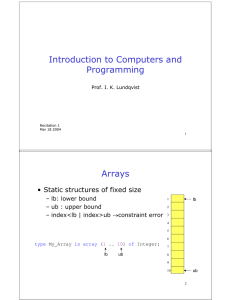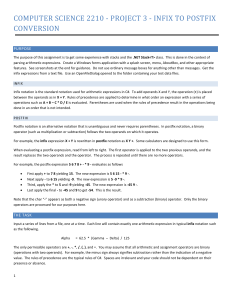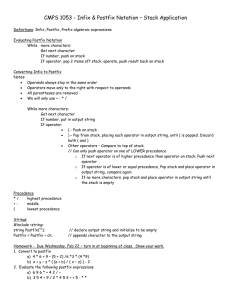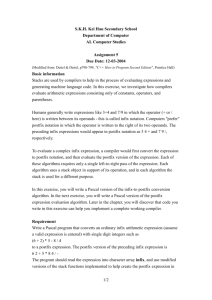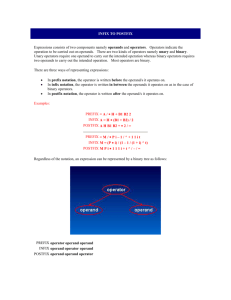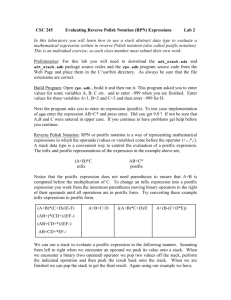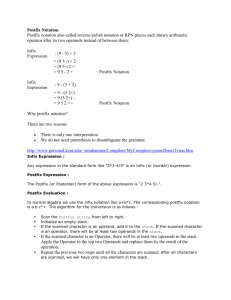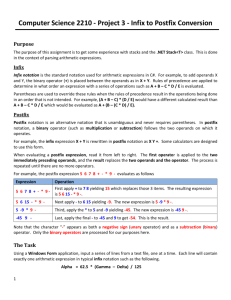Stack and its applications
advertisement
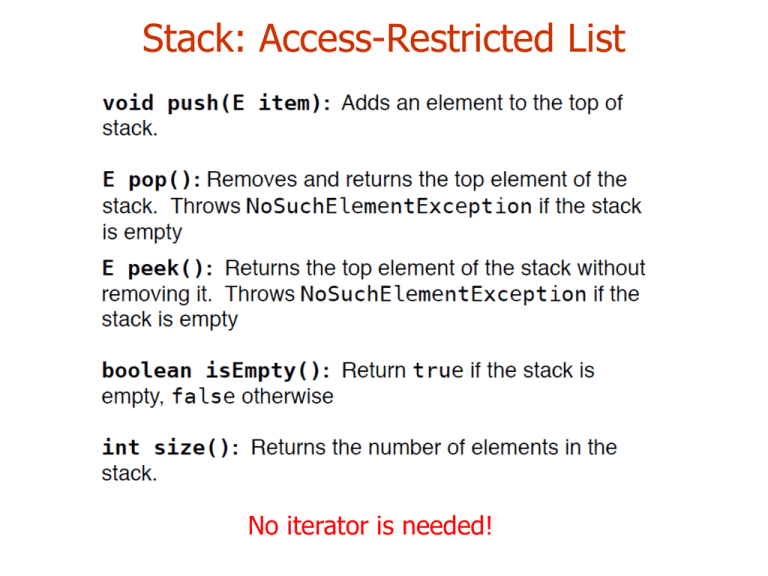
Stack: Access-Restricted List No iterator is needed! Java Implementations You can implement a stack using a Java List However, this comes with unnecessary features (and thus at the expense of efficiency) Light-weighted Implementations Array Implementation Linked-List Implementation Application of Stack: Verifying Matched Parentheses Application of Stack: Verifying Matched Parentheses Application of Stack: Verifying Matched Parentheses Application of Stack: Arithmetic Expression Evaluation Infix Notation Postfix Notation • Each binary operator is placed between its operands • Each unary operator precedes its operand • Also called Reverse Polish Notation (RPN) in which operands come before operators -2 + 3 * 5 <--> (-2) + (3 * 5) a b * c + <--> a * b + c Infix and postfix are equivalent Ex. infix a*b*c*d*e*f 1 + (-5) / (6 * (7+8)) (x/y – a*b) * ((b+x) – y^y ) postfix ab*c*d*e*f* 15-678+*/+ unary xy/ab*–bx+yy^–* (x*y*z – x^2 / (y*2 – z^3) + 1/z) * (x – y) xy*z*x2^y2*z3^ – / – 1z/+xy – * Advantages of Postfix • No need for parentheses • Easier to parse by computer than infix notation • Easy to implement using a stack (value on top of the stack) • Fast to evaluate The postfixExpression Class Take a postfix expression contained in a string and evaluates it Operands: single-digit nonnegative integers (for simplicity) Operators: +, -, *, /, %, ^ Postfix Evaluation Use an operand stack (to store, say, integer operands) • • • • • Start with an empty stack Scan the postfix expression from left to right Whenever you reach an number, push it onto the stack Whenever you reach an operator, OP, do the following: • Pop two items right and left off the stack • Evaluate (left OP right) • Push the value back to the stack When you reach the end of the expression, pop the single remaining item from the stack (this is the value of the expression) Example Infix expression: Postfix equivalent: (7 – 11) * 2 + 3 7 11 – 2 * 3 + step 1 7 2 11 – 2 * 3 + step 4 -4 *3+ 11 step 2 7 –2*3+ step 5 -8 3+ 2*3+ 3 step 6 -8 + step 7 -5 The result! step 3 -4 Possible Error 1: Too many operands During the evaluation, you can also check the correctness of a postfix expression. An error of the first type occurs when more than one operand is left on the stack at the end of the scan. 2 3 + 4 6 – 2 -2 5 3+46– 3 2 +46– 5 46– 4 5 6– 6 4 5 – Possible Error 2: Too many operators The second type of error occurs when less than two operands are left on the stack on scanning an operator. 2 3 +– 2 3+– 3 2 +– 5 – Infix expression evaluation Evaluating infix expression is non-trivial • Operators have different precedence () > ^ > * = % = / > + = 1 • Some operators are left associative: +, -, /, % • One operator is right associative ^ Infix to Postfix Conversion Let’s first consider a simpler case •All the operators are left associative •No parentheses Our algorithm uses a operator stack, opStack, to • temporarily store operators awaiting their right-handside operator • help manage the order of precedence Our algorithm Example Example1 Example2 Infix to Postfix Conversion (General Case) General case • • handling right associative handling parenthesis Our algorithm • Each operator has two, possibly different, precedences, depending on whether it is being scanned as part of the input infix expression or it is already on the stack. Algorithm Error Checking
